AMD Beema/Mullins Architecture & Performance Preview
by Anand Lal Shimpi on April 29, 2014 12:00 AM ESTThe Discovery Tablet
AMD is in a difficult position these days. Traditionally it was the cheaper alternative to Intel, but with Bay Trail Intel made a serious push into segments where OEMs would traditionally use lower cost AMD silicon. In an attempt to be more than a lower cost Intel alternative, AMD is throwing its hat into the form factor reference design race and offering OEMs an example of a full, ideal, high performance implementation of its silicon. One such example is AMD’s Discovery Tablet, an 11.6-inch 1080p Windows 8.1 tablet design that features AMD’s highest end A10 Micro-6700T Mullins silicon. The tablet is a bit larger and heavier than I’d like. If AMD is going to build a reference platform I’d prefer it to be a form factor I’d actually use, which in a tablet is going to be something smaller than 11.6-inches. If you are trying to cover both tablet and 2-in-1 form factors however, the Discovery Tablet makes sense.
I was allowed to spend a few hours benchmarking AMD’s Discovery Tablet. Unfortunately the device wasn’t instrumented for power testing, nor was there enough time to run any battery life tests on it, so the usefulness of these numbers is limited. We already know that AMD’s idle power isn’t as good as smartphone silicon, but for some of these value Windows 8.1 devices it may still be good enough.
Tablet JS/Web Browser Tests
We'll start with our usual set of JavaScript tests. Here we see AMD's A10 Micro-6700T outperform everything on the list. Whether we're talking about Bay Trail or Apple's A7, the 6700T pulls ahead by a decent margin. Once again the big question is how much power is being drawn to deliver this performance. Unlike Intel's Bay Trail preview, AMD didn't have any instrumented Discovery tablets setup for us to monitor power consumption. I suspect AMD's power consumption is competitive, but my guess is it isn't similarly class leading.
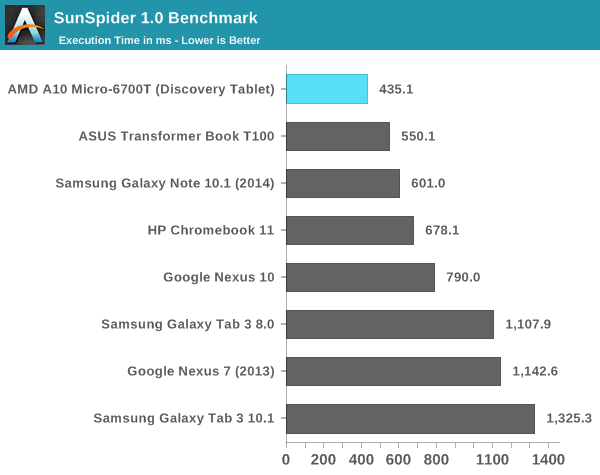
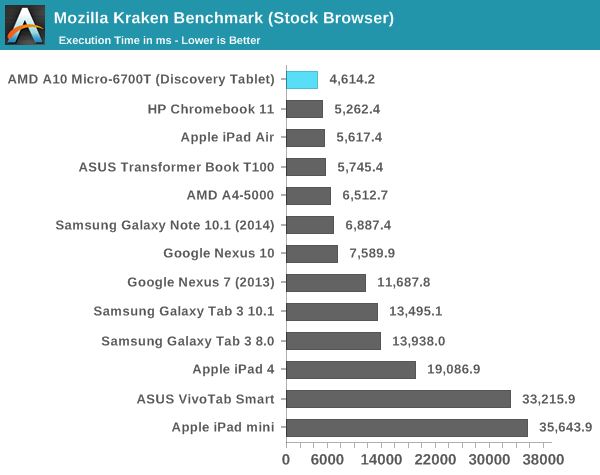

CPU Performance
For these next tests I turned to some of our more traditional Windows PC benchmarks. I looked at Cinebench 11.5 to get an idea for how single and multithreaded performance have changed since last year.
Looking at single threaded performance we immediately see the benefits of AMD's new boosting capabilities. The Puma+ cores are 35% faster than Intel's Silvermont cores, and can deliver nearly 80% of the performance of AMD's Piledriver cores found in Trinity. I threw some Llano results in here as well - Mullins offers around 85% of the performance of Llano.
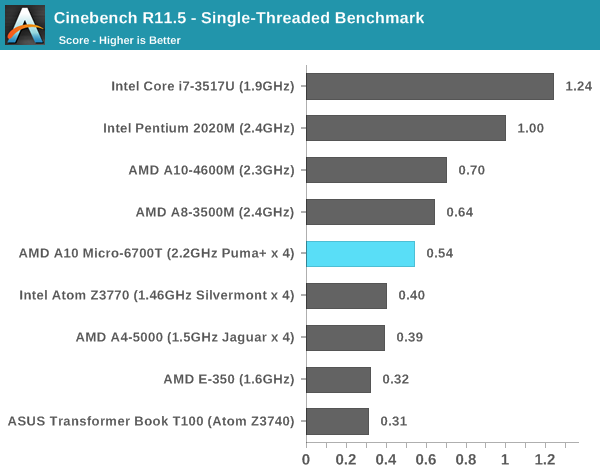
Multithreaded performance is pretty evenly matched between Bay Trail and Mullins here. Note that Mullins manages to deliver very similar performance to Kabini, despite coming in at substantially less power. The comparison to Brazos (E-350) is laughable, Mullins is substantially faster.
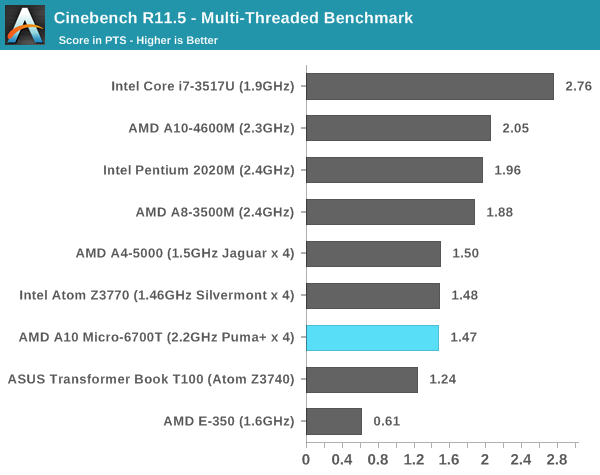
PCMark 7 gives us a better look at the overall performance of the Discovery tablet hardware. Here we do see it lose ground to the Kabini notebook (A4-5000) as well as the Bay Trail devices. It's unclear to me if we are seeing the thermal limits of the hardware (this is a longer test) or if there are other elements at work here (e.g. storage performance limits).
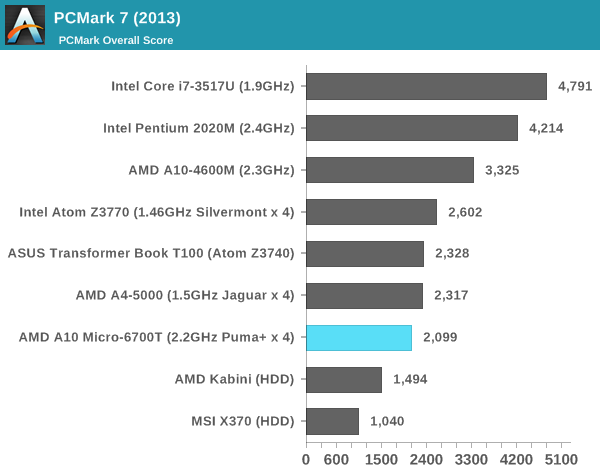
GPU Performance
We don’t actually have any Bay Trail devices in our Laptop 2013 bench, they are all in our Tablet 2013 category, which unfortunately uses different benchmarks. To make a long story short, we have Bay Trail vs. Kabini data, and Kabini vs. Mullins data. Thankfully the comparison between Bay Trail and Mullins is pretty easy to make.
AMD’s 4.5W TDP A10 Micro-6700T delivers roughly the same GPU performance as a 15W A4-5000. The A4-5000 also ends up being anywhere from 50% to over 2x the speed of Bay Trail when it comes to GPU performance, so you can expect Mullins to hold roughly the same advantage.
Compared to the old 35W Trinity, Mullins still has a ways to go. Trinity delivers roughly 2x the performance of Mullins, although at nearly 10x the TDP.
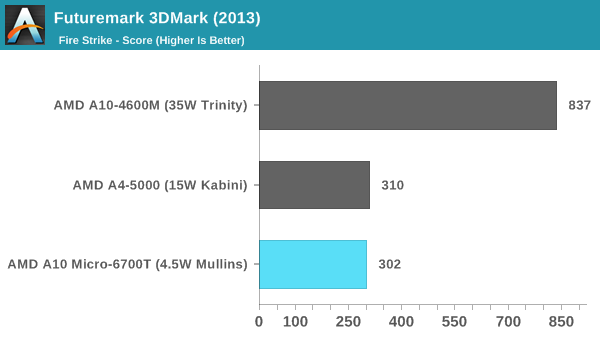
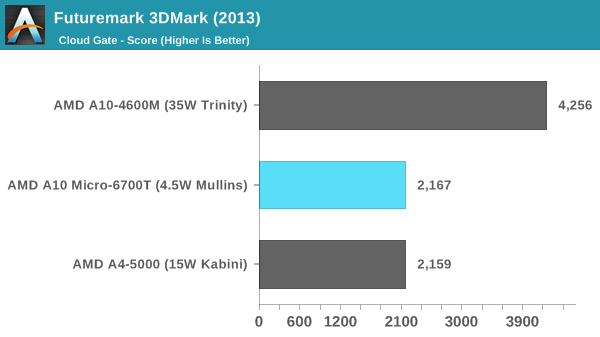
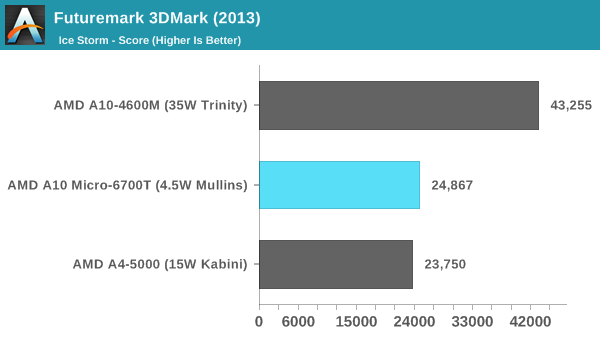


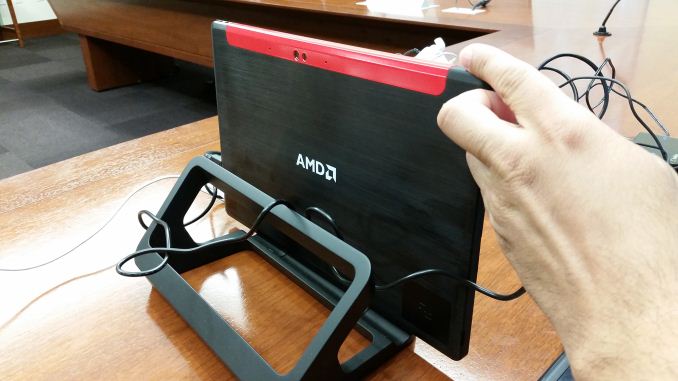
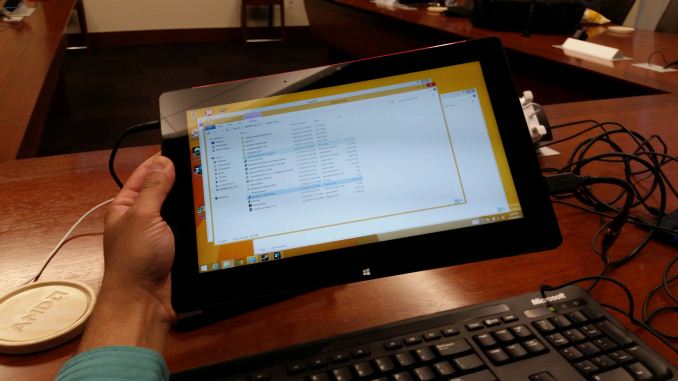














82 Comments
View All Comments
saneblane - Tuesday, April 29, 2014 - link
Unlock That 2.4GHZ Beema Pls. It sure would be nice to get an Amd quadcore 3GHZ at 25 watts.Amd Should increase the highend on these and kill of Low Power Kaveri.
MrHorizontal - Tuesday, April 29, 2014 - link
Interesting little package that.But very little detail on the memory controller - how wide is it? From what I can see it's just single channel. Personally I think these Puma cores would serve AMD a lot better as a low power Opteron CPU than ARM would, equivalent to Intel's Avoton package, provided they can use a significant amount of memory on a system - a single channel won't cut it.
MrSpadge - Tuesday, April 29, 2014 - link
Single channel, since it's I/O compatible with the previous chips.mfoley93 - Wednesday, April 30, 2014 - link
The author should add this, to the article, not everyone that is interested keeps up on this stuff closely enough to remember all of the details from 8 months ago.piroroadkill - Tuesday, April 29, 2014 - link
Makes you once again realise how wimpy the CPU is in the Xbox One and PS4.8 Jaguar cores. More crap is still crap.
These cores are far better than that, and still wouldn't be considered high end.
H2323 - Tuesday, April 29, 2014 - link
8 Jag cores that have access to fast memory are plenty good for a multi-threaded gametipoo - Tuesday, April 29, 2014 - link
Disagreed. It was a matter of performance for cost, and even though each Jaguar core may perform half as well as a high end desktop core, they were able to fit 8 cores into less die space than those bigger cores would have taken. If a developer takes good advantage of multithreading they'll be fine for a while.Antronman - Wednesday, April 30, 2014 - link
But they won't considering most engines used are multiplatform engines and the majority of the games made with those engines are single threaded.The performance sucks, no matter how you look at it.
Graphics have a big effect on performance, and the graphical power on the new consoles is...less than enough.
lmcd - Friday, May 2, 2014 - link
Are you kidding? Engines mean that things can be more threaded as it's more abstracted and so more time can be spent on threading (as opposed to rewrites and higher-level coding that a smaller team would deal with).coburn_c - Tuesday, April 29, 2014 - link
Oh look another AMD product launch with regressive performance... and yet another AMD product launch where their power usage is double that of the competition. Still I suppose it's an improvement, they could be at 4x the power usage now if they hadn't finally done some work. Well I suppose they can just lay off another 25% of the company, that'll sure help close the gap..